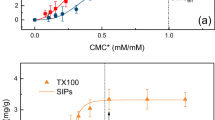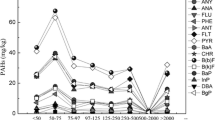Abstract
Purpose
Enhancing desorption of hydrophobic organic contaminants from soils is a promising approach for the effective remediation of soils contaminated with organic compounds. The desorption efficiency of chemical reagent, such as surfactant, should be evaluated. In this study, the effect of mixed anionic–nonionic surfactants sodium dodecylbenzene sulfonate (SDBS)–Tween 80 on the distribution of polycyclic aromatic hydrocarbons in soil–water system was evaluated.
Materials and methods
Batch desorption experiments were employed to evaluate the distribution of polycyclic aromatic hydrocarbons (PAHs) and surfactants in soil–water system. PAHs and SDBS were determined by high-performance liquid chromatography, Tween 80 by spectrophotometry, and total organic carbon with a carbon analyzer.
Results and discussion
Sorption of PAHs to soil was increased at low surfactant concentration due to the effective partition phase on soil formed by sorbed surfactants. The mixture of anionic and nonionic surfactants decreased the sorption of surfactants to soil, increasing the effective surfactant concentration in solution and thus decreasing the sorption of PAHs on soil. Anionic–nonionic mixed surfactant showed better performance on desorption of PAHs from soil than single surfactant. The greatest desorption efficiency was achieved with low proportions of SDBS (SDBS/Tween80 = 1:9).
Conclusions
SDBS–Tween 80 mixed surfactant showed the highest desorption rate with low proportion of SDBS, which indicated that the addition of relative low amount of anionic surfactant could significantly promote the desorption efficiency of PAHs by nonionic surfactants. Results obtained from this study did provide useful information in surfactant-enhanced remediation of soil and subsurface contaminated by hydrophobic organic compounds.





Similar content being viewed by others
References
Ahel M, Conrad T, Giger W (1987) Persistent organic chemicals in sewage effluents. 3. Determinations of nonylphenoxy carboxylic acids by high-resolution gas chromatography/mass spectrometry and high-performance liquid chromatography. Environ Sci Technol 21:697–703
Boyd SA, Lee JF, Mortland MM (1988) Attenuating organic contaminant mobility by soil modification. Nature 333:345–347
Chen B, Zhu L (2001) Partition of polycyclic aromatic hydrocarbons on organobentonites from water. J Environ Sci 13:129–136
Chiou CT, Peters LJ, Freed VH (1979) A physical concept of soil–water equilibria for nonionic organic compounds. Science 206:831–832
Deitsch JJ, Smith JA (1995) Effect of Triton X-100 on the rate of trichloroethene desorption from soil to water. Environ Sci Technol 29:1069–1080
Deshpande S, Shiau BJ, Wade D, Sabatini DA, Harwell JH (1999) Surfactant selection for enhancing ex situ soil washing. Water Res 33:351–360
Edwards DA, Luthy RG, Liu Z (1991) Solubilization of polycyclic aromatic hydrocarbons in micellar nonionic surfactant solutions. Environ Sci Technol 25:127–133
Karickhoff SW, Brown DS, Scott TA (1979) Sorption of hydrophobic pollutants on natural sediments. Water Res 13:241–248
Kile DE, Chiou CT (1989) Water solubility enhancements of DDT and trichlorobenzene by some surfactants below and above the critical micelle concentration. Environ Sci Technol 23:832–838
Lee JF, Liao PM, Kuo CC, Yang HT, Chiou CT (2000) Influence of a nonionic surfactant (Triton X-100) on contaminant distribution between water and several soil solids. J Colloid Interf Sci 229:445–452
Lee SY, Kim SJ, Chung SY, Jeong CH (2004) Sorption of hydrophobic organic compounds onto organoclays. Chemosphere 55:781–785
Lee M, Kang H, Do W (2005) Application of nonionic surfactant-enhanced in situ flushing to a diesel contaminated site. Water Res 39:139–146
Mathur S, Moudgil BM (1998) Mechanisms of nonionic polymer adsorption on oxide surfaces. Miner Metall Proc 15:24–28
Paria S (2008) Surfactant-enhanced remediation of organic contaminated soil and water. Adv Colloid Interfac Sci 138:24–58
Paria S, Yuet PK (2006) Effects of chain length and electrolyte on the adsorption of n-alkylpyridinium bromide surfactants at sand–water interfaces. Ind Eng Chem Res 45:712–718
Rouse JD, Sabatini DA, Harwell JH (1993) Minimizing surfactant losses using twin-head anionic surfactants in subsurface remediation. Environ Sci Technol 27:2072–2078
Rudel RA, Melly SJ, Geno PW, Sun G, Brody JG (1998) Identification of alkylphenols and other estrogenic phenolic compounds in wastewater, septage and groundwater on Cape Cod, Massachusetts. Environ Sci Technol 32:861–869
Sale T, Pitts M (1989) Chemically enhanced in situ soil washing. Proceedings of the Conference on Petroleum Hydrocarbons and Organic Chemical in Ground Water: Prevention, Detection and Restoration, 487, Houston. Dublin, Ohio, National Water Well Association
Stellner KL, Scamehorn JF (1989) Hardness tolerance of anionic surfactant solutions. 1. Anionic surfactant with added monovalent electrolyte. Langmuir 5:70–77
Thibaut A, Misselyn-Bauduin A, Grandjean J, Broze G, Jérôme R (2000) Adsorption of an aqueous mixture of surfactants on silica. Langmuir 16:9192–9198
West CC, Harwell JH (1992) Surfactants and subsurface remediation. Environ Sci Technol 26:2324–2330
Xu J, Yuan X, Dai S (2006) Effect of surfactants on desorption of aldicarb from spiked soil. Chemosphere 62:1630–1635
Yang K, Zhu L, Zhao B (2005) Minimizing losses of nonionic and anionic surfactants to a montmorillonite saturated with calcium using their mixtures. J Colloid Interf Sci 291:59–66
Yang K, Zhu L, Xing B (2006) Enhanced soil washing of phenanthrene by mixed solutions of TX100 and SDBS. Environ Sci Technol 40:4274–4280
Yang K, Zhu L, Xing B (2007) Sorption of sodium dodecylbenzene sulfonate by montmorillonite. Environ Pollut 145:571–576
Yeom IT, Ghosh MM, Coxd C (1996) Kinetic aspects of surfactant solubilization of soil-bound polycyclic aromatic hydrocarbons. Environ Sci Technol 30:1589–1595
Zhao B, Zhu L, Yang K (2006) Solubilization of DNAPLs by mixed surfactant: reduction in partitioning losses of nonionic surfactant. Chemosphere 62:772–779
Zheng Z, Obbard JP (2002) Evaluation of an elevated non-ionic surfactant critical micelle concentration in a soil/aqueous system. Water Res 36:2667–2672
Zhou W, Zhu L (2007a) Efficiency of surfactant-enhanced desorption for contaminated soils depending on the component characteristics of soil–surfactant–PAHs system. Environ Pollut 147:66–73
Zhou W, Zhu L (2007b) Enhanced desorption of phenanthrene from contaminated soil using anionic/nonionic mixed surfactant. Environ Pollut 147:350–357
Zhu L, Feng S (2003) Synergistic solubilization of polycyclic aromatic hydrocarbons by mixed anionic–nonionic surfactants. Chemosphere 53:459–467
Zhu L, Chen B, Tao S, Chiou CT (2003) Interactions of organic contaminants with mineral-adsorbed surfactants. Environ Sci Technol 37:4001–4006
Acknowledgements
We thank the National Natural Science Foundation of China (20737002, 20890110, 40973067) and the Program for Changjiang Scholars and Innovative Research Team in University (IRT0536) for financial support.
Author information
Authors and Affiliations
Corresponding author
Additional information
Responsible editor: Jean-Paul Schwitzguébel
Rights and permissions
About this article
Cite this article
Zhang, M., Zhu, L. Effect of SDBS–Tween 80 mixed surfactants on the distribution of polycyclic aromatic hydrocarbons in soil–water system. J Soils Sediments 10, 1123–1130 (2010). https://doi.org/10.1007/s11368-010-0215-5
Received:
Accepted:
Published:
Issue Date:
DOI: https://doi.org/10.1007/s11368-010-0215-5




